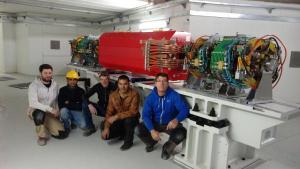
WASHINGTON — A new multidisciplinary center could help reduce the Middle East’s brain drain by creating scientific research opportunities and facilities close to home.
On Feb. 10, scientists and engineers finished installing the first magnet for running experiments at SESAME, the Synchrotron-light for Experimental Science and Applications in the Middle East.
“For me, it’s like a Disneyland,” said Gihan Kamel, a physicist on leave from Helwan University in Egypt, who is working on early measurements at the facility. Kamel and others involved in the project spoke during a Feb. 14 symposium at the American Association for the Advancement of Science (AAAS) annual meeting.
The facilities will find numerous applications in a range of disciplines. Biologists, for example, can use SESAME to decipher the structure of molecules, and from that, figure out their role, such as whether they cause plant stress.
SESAME will be the Middle East’s first synchrotron, a powerful X-ray-emitting device that, like a powerful microscope, lets scientists peer into atoms and molecules to figure out their structure, composition, and ultimately, their importance in materials or life processes.
The new SESAME facility is about 30 kilometers northwest of Jordan’s capital, Amman, and is helmed by Geneva-based CERN, the European Organization for Nuclear Research, which operates the world’s largest particle physics laboratory.
Most of the materials needed to build it are on site. Since the first magnet is now assembled, the facility should be ready to run initial experiments in 2017, said physicist Chris Llewellyn-Smith, president of the SESAME Council, the governing body of the project.
When operational, SESAME will be one of about 60 synchrotrons in use in the world. And Middle Eastern scientists will no longer have to travel to facilities far outside the region if they want to use a synchrotron for biology or engineering research.
The idea for SESAME grew out of decades-long discussions. In November 1995, about 150 physicists gathered inside a large tent on the east coast of Egypt to discuss Middle East science collaborations. During the talks there was a 6.9 magnitude earthquake.
“What more do you need as a sign that something is happening here?” said theoretical physicist Eliezer Rabinovici, who studies parallel universes at the Hebrew University of Jerusalem in Israel. Rabinovici is a founding father of the SESAME concept and vice president of its council.
Regional tensions slowed progress after the meeting. But, eventually the international community decided to build a synchrotron because of its many applications to science research, Rabinovici said.
In 1997, there was a suggestion to break down a machine in Germany and bring the parts to the Middle East to make a synchrotron. But the idea of building from old spare parts did not sit well with many.
“How do you take a machine which is going to be junk?” Rabinovici said. “What scientist is going to come to this machine?”
The SESAME community opted instead to construct a new machine. CERN received parts for the facility from several countries, put together the first magnet and shipped it to Jordan for installation. Now that the first of 16 magnets is installed, the project is another step closer to completion.
Egypt, Iran, Israel, the Palestinian Authority, Turkey and several other countries and governing bodies are participating in SESAME. The project is funded by donations from Europe and some Middle Eastern countries, including Israel and Egypt.
When complete, SESAME will have over 25 experiment stations. Two should be ready on the first day the facility goes live.
“It’s important that we get this going,” said Zehra Sayers, a biologist at Sabanci University in Turkey.
Many of her students have left Turkey to find work, so the facility may help her laboratory and others retain top talent. It also will foster collaboration and trust, since it supports multiple projects side by side, she said.
“People start to talk to each other because you’re tired and you want to keep yourself awake.”
Despite all the positive energy surrounding the project, leaders are concerned that it might become a target for militant groups. Still the project continues even with the political tensions in the Middle East.
“We are not politicians,” Kamel said after the symposium. “We are only scientists.”
Andrew Silver is a senior at University of Florida majoring in mathematics. His work has appeared in Science, Physics World, Live Science, and other outlets. He’s trying to learn Italian. Follow him on Twitter @asilver360.
